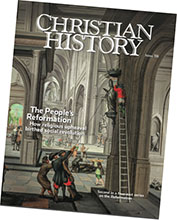Bride of the Reformation
BASEL WAS A BUSTLING HUB of commerce and culture in the early sixteenth century. From all over Europe, students flocked to its university, and writers brought their books to its presses. Military wife Margareta Rosenblatt and her daughter Wibrandis (1504–1564) lived there and moved in university-educated circles, where Wibrandis picked up German, Latin, and a husband, Ludwig Keller, whom she married in 1524 at the age of 20. Two years later Keller was dead.
Wibrandis soon became attracted to the Reformation teachings proclaimed by cathedral preacher Johannes Oecolampadius. When 45-year-old Oecolampadius married the 24-year-old widow in 1528, Erasmus quipped that the preacher had wed an attractive girl as his Lenten penance. In Oecolampadius’s own account, Wibrandis was a bit too young, but she was a good Christian, of respectable family but not rich, and had “several years’ experience bearing the cross.” He wrote: “My wife is what I always wanted. . . . She is not contentious, garrulous, or a gadabout, but looks after the household.”
Throughout southern Germany and Switzerland, as a like-minded group of theologians took control of the religious life of some of the region’s most important city-states, they and their wives formed a theological and social circle. Elisabeth Bucer, Agnes Capito, and Anna Zwingli all corresponded with Wibrandis.
Death and marriage and . . .
Oecolampadius and Agnes Capito both died in November 1531, leaving children and widowed spouses; in the sixteenth century, this situation called for immediate remarriage. Bucer feared that Capito might marry the widow of a martyred Anabaptist leader; he had Anabaptist leanings and was, in Bucer’s view, an impulsive sort who needed a practical wife to put up with his eccentricities, provide for his needs, and link him more firmly to the Protestant mainstream. Wibrandis fit the bill. Capito (over 50 at the time) proposed and brought her to Strasbourg. Once again Wibrandis found herself living in a major center of the Reformation.
Order Christian History #118: The People’s Reformation in print.
Subscribe now to get future print issues in your mailbox (donation requested but not required).
After the ill-fated Regensburg Colloquy in 1541, plague swept Strasbourg. Four of Bucer’s five children died, and the Capitos lost two of theirs plus Wibrandis’s son Eusebius Oecolampadius. Then Capito and Elisabeth Bucer were stricken. As Martin and Wibrandis stood by Elisabeth’s deathbed, she made them promise to marry each other and provide for both families. “We could not answer except by tears,” Bucer recalled later.
In March 1542 the 51-year-old Bucer fulfilled Elisabeth’s dying wish. He traveled frequently; Wibrandis, in weak health, managed the household, took care of the children (two from Oecolampadius, two from Capito, two from Bucer, and her stepson from Bucer’s first marriage), entertained guests, adopted needy children, and gave shelter to students and refugees.
In 1548 Bucer was offered a post as theology professor at Cambridge. Lonely, discouraged, and convinced the failure of German Protestantism was due to sinful Protestants, he lectured to his English students with a dour prophetic insistence. He found English winters bitterly cold, and a special German stove was constructed for him. The food, he complained to Wibrandis, was nothing but meat.
Wibrandis decided that everyone should emigrate. Narrowly escaping a Catholic official who was trying to confiscate her property (she admitted that she might have “said something hot”), she herded the whole family to England, where she nursed Martin through two more difficult winters. In 1551 he died; Wibrandis returned to Strasbourg and then Basel, where she lived for more than 10 years as a respected matriarch until her death (in yet another plague epidemic).
From the heady beginnings in Basel to the stress and bustle of Strasbourg to the wintry gloom of Edwardian England, Wibrandis played a key supporting role in the unfolding Reformation. The men she married were among the most moderate Protestant leaders. They combined learning with reforming fire and, against great odds, struggled to hold the Protestant movement together and make it a genuine renewal of the church.
This article is from Christian History magazine #118 The People’s Reformation. Read it in context here!
Christian History’s 2015–2017 four-part Reformation series is available as a four-pack. This set includes issue #115 Luther Leads the Way; issue #118 The People’s Reformation; issue #120 Calvin, Councils, and Confessions; and issue#122 The Catholic Reformation. Get your set today. These also make good gifts.
By Edwin Woodruff Tait
[Christian History originally published this article in Christian History Issue #118 in 2016]
Edwin Woodruff Tait. This article is adapted from issue 84.Next articles
BONUS ONLINE CONTENT: What’s in a name?
The surprising origin of the term “Protestant”
Jennifer Woodruff TaitBONUS ONLINE CONTENT: The road not taken II
Cardinal Contarini and the Colloquy of Regensburg
David C. SteinmetzSupport us
Christian History Institute (CHI) is a non-profit Pennsylvania corporation founded in 1982. Your donations support the continuation of this ministry
Donate






